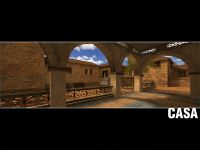Truth to be told, it’s unfinished, but I got fed up with it:-P
Attachment:
 will-frag-for-fun.png [ 1.45 MiB | Viewed 4414 times ]
will-frag-for-fun.png [ 1.45 MiB | Viewed 4414 times ]
Attachment:
 will-frag-for-fun-anim.gif [ 347.47 KiB | Viewed 3326 times ]
will-frag-for-fun-anim.gif [ 347.47 KiB | Viewed 3326 times ]
Infodump of the TL;DR variety follows:
The composition of this piece is semi-accidental — I googled for “beggar” and came up with a few good reference photos, especially this one:
Attachment:
 m6-jalpan-begger.JPG [ 65.8 KiB | Viewed 4414 times ]
m6-jalpan-begger.JPG [ 65.8 KiB | Viewed 4414 times ]
Luckily, I decided to continue search with the Estonian word (“kerjus”) and right away came across this perfect scene that looked
exactly as I had imagined my painting. (
Shot in San Cristóbal de las Casas, a Mexican highlands town.) I can’t really consciously enumerate the reasons I like it, but among other things, it looks very UrT-y — the walls and lighting resemble two popular maps (Casa & Algiers) that have been part of the game since time immemorial.
Attachment:
 img_7401.png [ 185.13 KiB | Viewed 4414 times ]
img_7401.png [ 185.13 KiB | Viewed 4414 times ]
Even if I hadn’t known already, painting the walls and steps would’ve made obvious why rundown environments are so popular with video game makers: they’re ridiculously easy to make seem real. When you have a featureless white wall, in reality you’d have cues that would require a lot of tweaking (and an engine that’s only been possible for half a dozen years or so) to translate into game graphics. Is it plaster? Is it paint? Is it, perhaps, plastic? Without a bunch of subtle cues, it’s just a white rectangle, and looks FAAAAAKE. Worn and dirty surfaces, however, are the easiest thing to do; hell,
Duke Nukem 3D had pretty good, if blocky, rusty steel with flaking paint…
One of the most fundamental problems an aspiring artist comes across is the trouble distinguishing between saturation and value (chroma and luma) — brighter colors seem lighter while still making the detail clash with the surroundings. Fortunately, when painting digitally, there’s an easy workaround: by desaturating the image (converting to grayscale), you see the actual values. Something that
might look slightly off
will look completely wrong in black and white — and when paiting digitally, adjusting the offending bits is easy, too. The reason for this is that our vision relies on quick and dirty comparison algorithms
executed in the eye itself — essentially, values bleed into adjacent ones and as a result, we can amuse ourselves with trick images like this:
Attachment:
 tumblr_m5zwhafJht1r0wqrdo1_500.jpg [ 38.12 KiB | Viewed 3326 times ]
tumblr_m5zwhafJht1r0wqrdo1_500.jpg [ 38.12 KiB | Viewed 3326 times ]
Finally: I had planned to paint this piece more roughly, concentrating on getting the colors right, rather than trying to detail everything (the bane of amateurs). But by the time I started with body, I had already smoothed out the rifle and, not wanting to undo my work, had quite literally painted myself in the corner. Better luck next time?


















